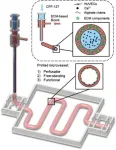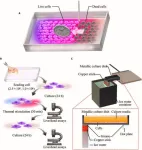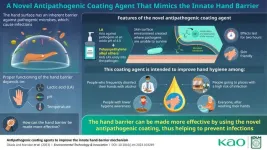Bioprinting methods for fabricating in vitro tubular blood vessel models
2023-09-07
(Press-News.org)
A review paper by scientists at the Chonnam National University summarized the recent research on bioprinting methods for fabricating bioengineered blood vessel models. The new review paper, published on Aug. 1 in the journal Cyborg and Bionic Systems, provided an overview on the 3D bioprinting methods for fabricating bioengineered blood vessel models and described possible advancements from tubular to vascular models.
“3D bioprinting technology provides a more precise and effective means for investigating biological processes and developing new treatments than traditional 2D cell cultures. Therefore, it is a crucial tool in the field of regenerative medicine and biological research.” explained study author Hee-Gyeong Yi, a professor at the Chonnam National University. Two-dimensional (2D) blood vessel models have difficulties in mimicking the three-dimensional (3D) microenvironment in human, simulating kinetics related to cell activities, and replicating human pathophysiology. “In vitro bioengineered models created through biofabrication based on tissue engineering and regenerative medicine are breakthrough models that can overcome limitations of 2D and animal models.” said study authors. Thus, they reviewed the 3D bioprinting methods for fabricating bioengineered blood vessel models and described possible advancements from tubular to vascular models.
Bioengineered models (BMs) are innovative models that can overcome limitations of 2D and animal models to allow simulation of the natural microenvironment in the human body in a patient- and target-specific manner. “BMs can be used to verify the safety and efficacy of drugs and medical devices by recreating structures and functions that maximally resemble those of tissues and organs in vitro.” said Yi.
The study authors discussed recent 3D bioprinting methods for fabricating bioengineered blood vessel models. Coaxial nozzle bioprinting, for example, is a 3D bioprinting technique used to fabricate structures of concentric shapes via simultaneous printing of bioink of two different materials.
Looking forward the possible advancements from tubular to vascular models. Bioprinting can be used to fabricate blood vessels with complex, micro-scale structures in vitro for the construction of in vitro models featuring multiple connected tissues. Moreover, fabrication of vascularized tissues that closely resemble anatomical tissues will allow a detailed in vitro examination of diseases related to blood vessels and further large-scale fabrication of diverse, large-caliber tissues. Recent rapid advancement of techniques to fabricate in vitro models is expected to overcome current limitations, paving the way for more accurate drug evaluation and efficacy analyses of blood vessels and blood flow dynamics in the body.
“Advancements in scaffold fabrication techniques, such as electrospinning or 3D scaffolding approaches, and fine-tuning printing parameters based on the specific requirements of tubular structures and complex tissue models can contribute to the creation of more intricate and tailored structures.” said Yi. The review paper calls for researchers, medical professionals, engineers, and other experts to collaboratively marshal the research on 3D bioprinting methods for fabricating bioengineered blood vessel models into practical applications that study human physiology and diseases in a more relevant and accurate manner.
Authors of the paper include Seon-Jin Kim, Min-Gyun Kim, Jangho Kim, Jessie S. Jeon, Jinsoo Park, Hee-Gyeong Yi
National Research Foundation of Korea (NRF) (grant no. 2020R1A5A8018367) funded by the Korea government (MSIT).
The paper, “Bioprinting methods for fabricating in vitro tubular blood vessel models” was published in the journal Cyborg and Bionic Systems on August 1, 2023, at DOI: https://spj.science.org/doi/10.34133/cbsystems.0043.
END
[Attachments] See images for this press release:

ELSE PRESS RELEASES FROM THIS DATE:
2023-09-07
Hyperthermia is a potentially non-invasive cancer treatment that capitalizes on the heat intolerance of cancer cells, which are more sensitive than normal cells. In order to induce effective hyperthermia, it is necessary to apply the appropriate temperature according to the cell type, i.e., to comprehensively study the thermal toxicity of the cells, which requires accurate regulation of the culture temperature. Researchers from Keio University in Japan have developed a cell culture system with temperature ...
2023-09-07
Research Highlights:
More than half of adults (55%) with uncontrolled blood pressure who enrolled in a digital monitoring program that connected patients with clinical advice and included a bilingual app paired with at-home blood pressure monitors had controlled final blood pressure measurements after participating for least 90 days.
Patients using the Spanish-language version of the digital monitoring program demonstrated more improvement in blood pressure control than patients who used the English-language version.
Embargoed until 6:30a.m. CT/7:30 a.m. ET Thursday, Sept. 7, 2023
BOSTON, Sept. 7, 2023 — Over half of patients ...
2023-09-07
Research Highlights:
An analysis of data from a long-running study of more than 11,000 adults from four diverse communities in the United States has found that adults who had high blood pressure while both seated upright and lying supine (flat on their backs) had a higher risk of heart disease, stroke, heart failure or premature death compared to adults without high blood pressure while upright and supine.
Adults who had high blood pressure while lying supine but not while seated upright had similar elevated risks of heart attack, stroke, ...
2023-09-07
Research Highlights:
An analysis of electronic health records for more than 60,000 adults in the United States found that systolic, or top-number, blood pressure rose slightly during the winter compared to summer months. The health records were of adults being treated for high blood pressure from 2018 to 2023 at six health care centers of varying sizes located in the southeast and midwestern United States.
The researchers found that, on average, participants’ systolic blood pressure increased by up to 1.7 mm Hg in the winter months compared to the summer months.
They also found that population ...
2023-09-07
Research Highlights:
Community health centers participating in the National Hypertension Control Initiative (NHCI) that introduced self-measured blood pressure interventions to their patients — including individuals from Black, Hispanic and American Indian/Alaskan Native populations, who are disproportionately impacted by hypertension and by the COVID-19 pandemic — experienced improvements in blood pressure control rates since 2021, when NHCI began.
Community Health Centers in the NHCI that received funding from the U.S. Department of Health and Human Service’s Health Resources and Services Administration and Office of Minority Health and ...
2023-09-07
Heart problems after a COVID infection are a serious concern for both elite athletes and recreational athletes alike. A study from Amsterdam UMC, published today in Heart, offers some reassuring news. "We examined over 250 elite athletes and found that those who had contracted COVID-19 did not experience severe heart issues that impacted their careers," says Juliette van Hattum, a PhD candidate in sports cardiology at Amsterdam UMC.
The study specifically focused on elite athletes, a group that could be particularly susceptible to heart issues, particularly heart ...
2023-09-07
Antarctica’s vast ice masses seem far away, yet they store enough water to raise global sea levels by several meters. A team of experts from European research institutes has now provided the first systematic stability inspection of the ice sheet’s current state. Their diagnosis: While they found no indication of irreversible, self-reinforcing retreat of the ice sheet in West Antarctica yet, global warming to date could already be enough to trigger the slow but certain loss of ice over the next hundreds to thousands ...
2023-09-07
Early findings of two studies from the University of Michigan Rogel Cancer Center shed light on new ways to anticipate recurrence in HPV-positive head and neck cancer sooner. The papers, published in Cancer and Oral Oncology, offer clinical and technological perspectives on how to measure if recurrence is happening earlier than current blood tests allow, and provide a framework for a new, more sensitive blood test that could help in this monitoring.
“When metastatic head and neck cancer returns, it impacts their quality of life and can be disfiguring, interfering with the ability to talk, ...
2023-09-07
For the past decade, companies across North America have paid more attention to supporting equity, diversity and inclusion (EDI). This has prompted many organizations to create a leadership role fully dedicated to advancing EDI — so much so that between 2015 and 2020, the job title “head of diversity” increased 107 percent on LinkedIn. By 2021, more than half of S&P 500 firms had named a chief diversity officer.
But a new study from the UBC Sauder School of Business shows many people have deeply held beliefs about who should ...
2023-09-07
Contact infection is among the most common ways pathogens, such as bacteria and viruses, spread from one person to another. Hand washing and disinfection are important hygiene practices to minimize the probability of catching infectious diseases. Interestingly, our hands also have a natural barrier that fights off pathogens. While this had been known to science for quite some time, the exact mechanisms by which this barrier acts on pathogens remained a mystery until recently.
In a 2021 study published in Scientific Reports, researchers from Kao Corporation, Japan, revealed that lactic acid (LA), which has a molecular ...
LAST 30 PRESS RELEASES:
[Press-News.org] Bioprinting methods for fabricating in vitro tubular blood vessel models


